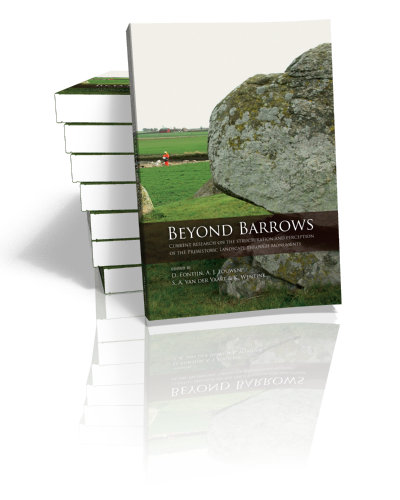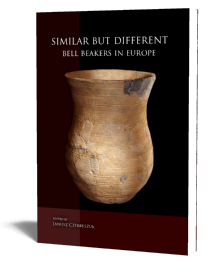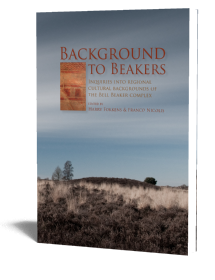Beyond Barrows
Current research on the structuration and perception of the Prehistoric Landscape through Monuments
edited by David Fontijn, Arjan Louwen, Sasja van der Vaart-Verschoof & Karsten Wentink | 2013

Beyond Barrows
Current research on the structuration and perception of the Prehistoric Landscape through Monuments
edited by David Fontijn, Arjan Louwen, Sasja van der Vaart-Verschoof & Karsten Wentink | 2013
Paperback ISBN: 9789088901089 | Imprint: Sidestone Press | Format: 182x257mm | 280 pp. | Language: English | 100 illus. (bw) | 50 illus. (fc) | Keywords: archaeology, prehistory, monuments, barrows | download cover
Read online or downloaded 2669 times
-
Digital & Online access
This is a full Open Access publication, click below to buy in print, browse, or download for free.
-
Buy via Sidestone (EU & UK)
-
Buy via our Distributors (WORLD)
For non-EU or UK destinations you can buy our books via our international distributors. Although prices may vary this will ensure speedy delivery and reduction in shipping costs or import tax. But you can also order with us directly via the module above.
UK international distributor
USA international distributor
-
Bookinfo
Paperback ISBN: 9789088901089 | Imprint: Sidestone Press | Format: 182x257mm | 280 pp. | Language: English | 100 illus. (bw) | 50 illus. (fc) | Keywords: archaeology, prehistory, monuments, barrows | download cover
Read online or downloaded 2669 times

We will plant a tree for each order containing a paperback or hardback book via OneTreePlanted.org.
Europe is dotted with tens of thousands of prehistoric barrows. In spite of their ubiquity, little is known on the role they had in pre- and protohistoric landscapes. In 2010, an international group of archaeologists came together at the conference of the European Association of Archaeologists in The Hague to discuss and review current research on this topic. This book presents the proceedings of that session.
The focus is on the prehistory of Scandinavia and the Low Countries, but also includes an excursion to huge prehistoric mounds in the southeast of North America. One contribution presents new evidence on how the immediate environment of Neolithic Funnel Beaker (TRB) culture megaliths was ordered, another one discusses the role of remarkable single and double post alignments around Bronze and Iron Age burial mounds. Zooming out, several chapters deal with the place of barrows in the broader landscape. The significance of humanly-managed heath in relation to barrow groups is discussed, and one contribution emphasizes how barrow orderings not only reflect spatial organization, but are also important as conceptual anchors structuring prehistoric perception. Other authors, dealing with Early Neolithic persistent places and with Late Bronze Age/Early Iron Age urnfields, argue that we should also look beyond monumentality in order to understand long-term use of “ritual landscapes”.
The book contains an important contribution by the well-known Swedish archaeologist Tore Artelius on how Bronze Age barrows were structurally re-used by pre-Christian Vikings. This is his last article, written briefly before his death. This book is dedicated to his memory.
This publication is part of the Ancestral Mounds Research Project of the University of Leiden: overview of the other Ancestral Mounds-publications
Beyond Barrows – an introduction
By David Fontijn
Inventions of Memory and Meaning – Examples of Late Iron Age Reuse of Bronze Age Monuments in South-Western Sweden
By Tore Artelius†
Part I (Beyond monumentality)
Memorious Monuments. Place persistency, mortuary practice and memory in the Lower Rhine Area wetlands (5500-2500 cal BC)
By Luc W.S.W. Amkreutz
The centrality of urnfields. Second thoughts on structure and stability of Late Bronze Age and Early Iron Age cultural landscapes in the Low Countries.
By Roy van Beek and Arjan Louwen
Part II (Orderings of funerary landscapes)
Döserygg and Skegrie. Megalithic centres in south-west Scania, southern Sweden
By Magnus Andersson and Björn Wallebom
Post alignments in the barrow cemeteries of Oss-Vorstengraf and Oss-Zevenbergen
By Harry Fokkens
Part III (Zooming out: barrows in a landscape)
Bronze Age barrow research in Sandy Flanders (NW Belgium): an overview
By Jeroen De Reu and Jean Bourgeois
history of open space. Barrow landscapes and the significance of heaths – the case of the Echoput barrows
By Marieke Doorenbosch
Ways of Wandering – In the Late Bronze Age Barrow Landscape of the Himmerland-area, Denmark
By Mette Løvschal
Part IV monument-building – an evolutionary approach
The Bet-Hedging Model as an Explanatory Framework for the Evolution of Mound Building in the Southeastern United States
By Evan Peacock and Janet Rafferty

Dr. Sasja van der Vaart-Verschoof
Sasja van der Vaart-Verschoof is a freelance consultant, researcher and editor known as the Overdressed Archeologist & Editor. In addition to publishing half a dozen books with us, she frequently collaborates with Sidestone Press doing both copy editing, book design and our social media marketing.

Dr. Arjan Louwen
Arjan Louwen (1986) studied ‘Prehistory of Northwest Europe’ at Leiden University. Already as a student he developed a keen interest in funerary archaeology and took part in several key-excavations of prehistoric barrows and urnfields. After graduation in 2010, Arjan has worked alternatingly in commercial archaeology (Archol bv. Leiden) and for Leiden University as a field archaeologist. Since 2012 he has worked full-time at Leiden University, first as a teacher and field director, later as PhD-student. His PhD-research revolved around the funerary practices associated with the urnfields in the Lower-Rhine-Basin. Arjan is currently still working at Leiden University as a teacher and trains students in their first field skills.

Prof. dr. David Fontijn
David Fontijn (1971-2023) was professor in the Archaeology of Early Europe at the Faculty of Archaeology, University of Leiden, the Netherlands. His research dealt with the early agrarian societies of Europe from prehistory up until the early historical period, with a particular focus on the Bronze and (early) Iron Age, the exchange and deposition of metalwork and the archaeology of so-called ritual landscapes. He led the NWO-VICI project ‘Economies of Destruction’ investigating the puzzling destruction of valuable objects in Bronze Age Europe (2015-).

Dr. Karsten Wentink
Karsten Wentink started his studies in 2001 at the Faculty of Archaeology, Leiden University. He did a combined bachelors in both archaeological sciences (focus on functional analysis at the Laboratory for Artefact studies) and prehistoric archaeology (with a focus on the Neolithic of North-West Europe). He finished his Masters thesis in 2006 on Neolithic flint axe depositions. He started his PhD research in 2008 focussing on the role of grave sets in Corded Ware and Bell Beaker funerary practices.
Abstract:
Europe is dotted with tens of thousands of prehistoric barrows. In spite of their ubiquity, little is known on the role they had in pre- and protohistoric landscapes. In 2010, an international group of archaeologists came together at the conference of the European Association of Archaeologists in The Hague to discuss and review current research on this topic. This book presents the proceedings of that session.
The focus is on the prehistory of Scandinavia and the Low Countries, but also includes an excursion to huge prehistoric mounds in the southeast of North America. One contribution presents new evidence on how the immediate environment of Neolithic Funnel Beaker (TRB) culture megaliths was ordered, another one discusses the role of remarkable single and double post alignments around Bronze and Iron Age burial mounds. Zooming out, several chapters deal with the place of barrows in the broader landscape. The significance of humanly-managed heath in relation to barrow groups is discussed, and one contribution emphasizes how barrow orderings not only reflect spatial organization, but are also important as conceptual anchors structuring prehistoric perception. Other authors, dealing with Early Neolithic persistent places and with Late Bronze Age/Early Iron Age urnfields, argue that we should also look beyond monumentality in order to understand long-term use of “ritual landscapes”.
The book contains an important contribution by the well-known Swedish archaeologist Tore Artelius on how Bronze Age barrows were structurally re-used by pre-Christian Vikings. This is his last article, written briefly before his death. This book is dedicated to his memory.
This publication is part of the Ancestral Mounds Research Project of the University of Leiden: overview of the other Ancestral Mounds-publications
Contents
Beyond Barrows – an introduction
By David Fontijn
Inventions of Memory and Meaning – Examples of Late Iron Age Reuse of Bronze Age Monuments in South-Western Sweden
By Tore Artelius†
Part I (Beyond monumentality)
Memorious Monuments. Place persistency, mortuary practice and memory in the Lower Rhine Area wetlands (5500-2500 cal BC)
By Luc W.S.W. Amkreutz
The centrality of urnfields. Second thoughts on structure and stability of Late Bronze Age and Early Iron Age cultural landscapes in the Low Countries.
By Roy van Beek and Arjan Louwen
Part II (Orderings of funerary landscapes)
Döserygg and Skegrie. Megalithic centres in south-west Scania, southern Sweden
By Magnus Andersson and Björn Wallebom
Post alignments in the barrow cemeteries of Oss-Vorstengraf and Oss-Zevenbergen
By Harry Fokkens
Part III (Zooming out: barrows in a landscape)
Bronze Age barrow research in Sandy Flanders (NW Belgium): an overview
By Jeroen De Reu and Jean Bourgeois
history of open space. Barrow landscapes and the significance of heaths – the case of the Echoput barrows
By Marieke Doorenbosch
Ways of Wandering – In the Late Bronze Age Barrow Landscape of the Himmerland-area, Denmark
By Mette Løvschal
Part IV monument-building – an evolutionary approach
The Bet-Hedging Model as an Explanatory Framework for the Evolution of Mound Building in the Southeastern United States
By Evan Peacock and Janet Rafferty

Dr. Sasja van der Vaart-Verschoof
Sasja van der Vaart-Verschoof is a freelance consultant, researcher and editor known as the Overdressed Archeologist & Editor. In addition to publishing half a dozen books with us, she frequently collaborates with Sidestone Press doing both copy editing, book design and our social media marketing.

Dr. Arjan Louwen
Arjan Louwen (1986) studied ‘Prehistory of Northwest Europe’ at Leiden University. Already as a student he developed a keen interest in funerary archaeology and took part in several key-excavations of prehistoric barrows and urnfields. After graduation in 2010, Arjan has worked alternatingly in commercial archaeology (Archol bv. Leiden) and for Leiden University as a field archaeologist. Since 2012 he has worked full-time at Leiden University, first as a teacher and field director, later as PhD-student. His PhD-research revolved around the funerary practices associated with the urnfields in the Lower-Rhine-Basin. Arjan is currently still working at Leiden University as a teacher and trains students in their first field skills.

Prof. dr. David Fontijn
David Fontijn (1971-2023) was professor in the Archaeology of Early Europe at the Faculty of Archaeology, University of Leiden, the Netherlands. His research dealt with the early agrarian societies of Europe from prehistory up until the early historical period, with a particular focus on the Bronze and (early) Iron Age, the exchange and deposition of metalwork and the archaeology of so-called ritual landscapes. He led the NWO-VICI project ‘Economies of Destruction’ investigating the puzzling destruction of valuable objects in Bronze Age Europe (2015-).

Dr. Karsten Wentink
Karsten Wentink started his studies in 2001 at the Faculty of Archaeology, Leiden University. He did a combined bachelors in both archaeological sciences (focus on functional analysis at the Laboratory for Artefact studies) and prehistoric archaeology (with a focus on the Neolithic of North-West Europe). He finished his Masters thesis in 2006 on Neolithic flint axe depositions. He started his PhD research in 2008 focussing on the role of grave sets in Corded Ware and Bell Beaker funerary practices.
-
Digital & Online access
This is a full Open Access publication, click below to buy in print, browse, or download for free.
-
Buy via Sidestone (EU & UK)
-
Buy via our Distributors (WORLD)
For non-EU or UK destinations you can buy our books via our international distributors. Although prices may vary this will ensure speedy delivery and reduction in shipping costs or import tax. But you can also order with us directly via the module above.
UK international distributor
USA international distributor
- Browse all books by subject
-
Search all books

We will plant a tree for each order containing a paperback or hardback book via OneTreePlanted.org.
You might also like:
© 2025 Sidestone Press KvK nr. 28114891 Privacy policy Sidestone Newsletter Terms and Conditions (Dutch)








